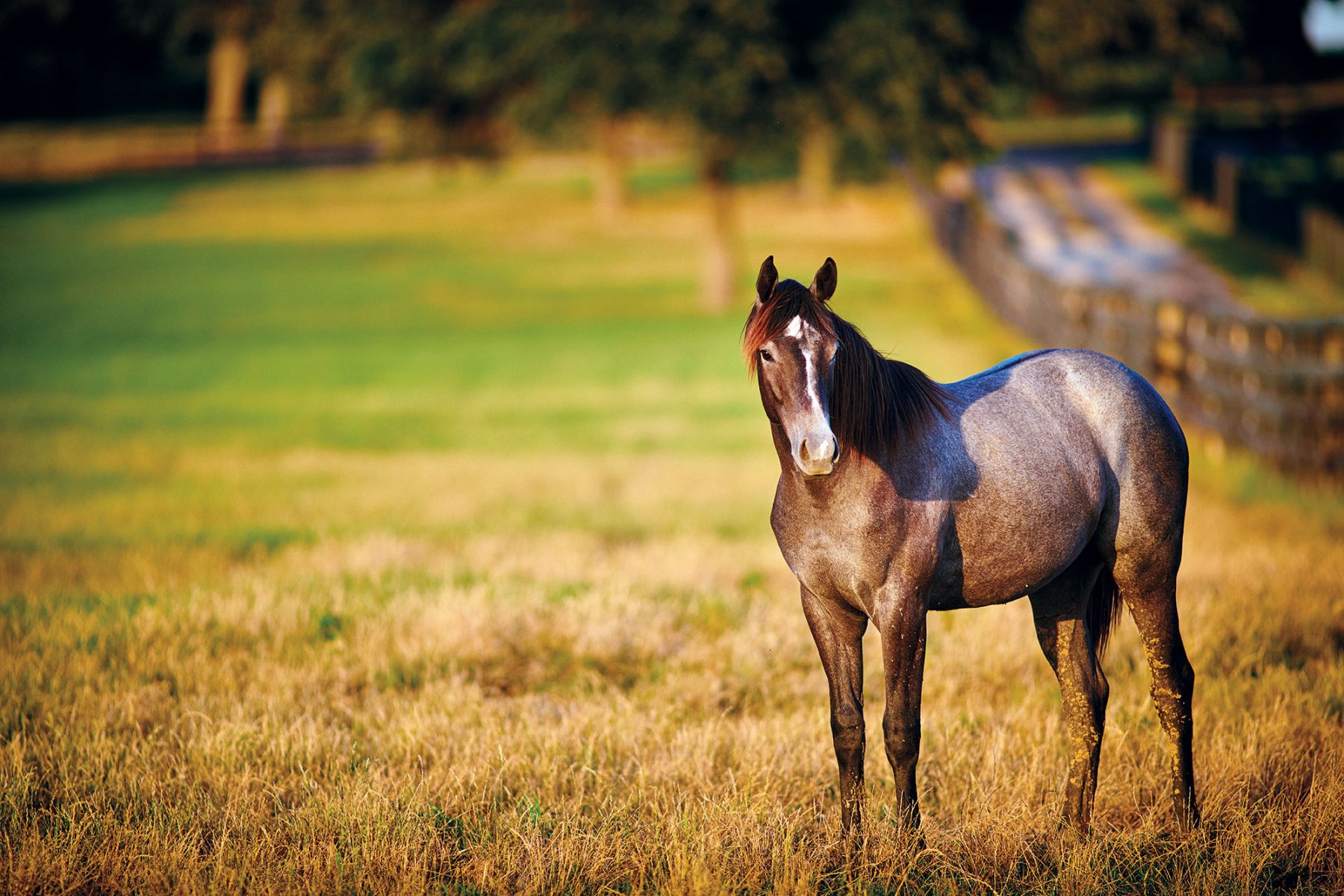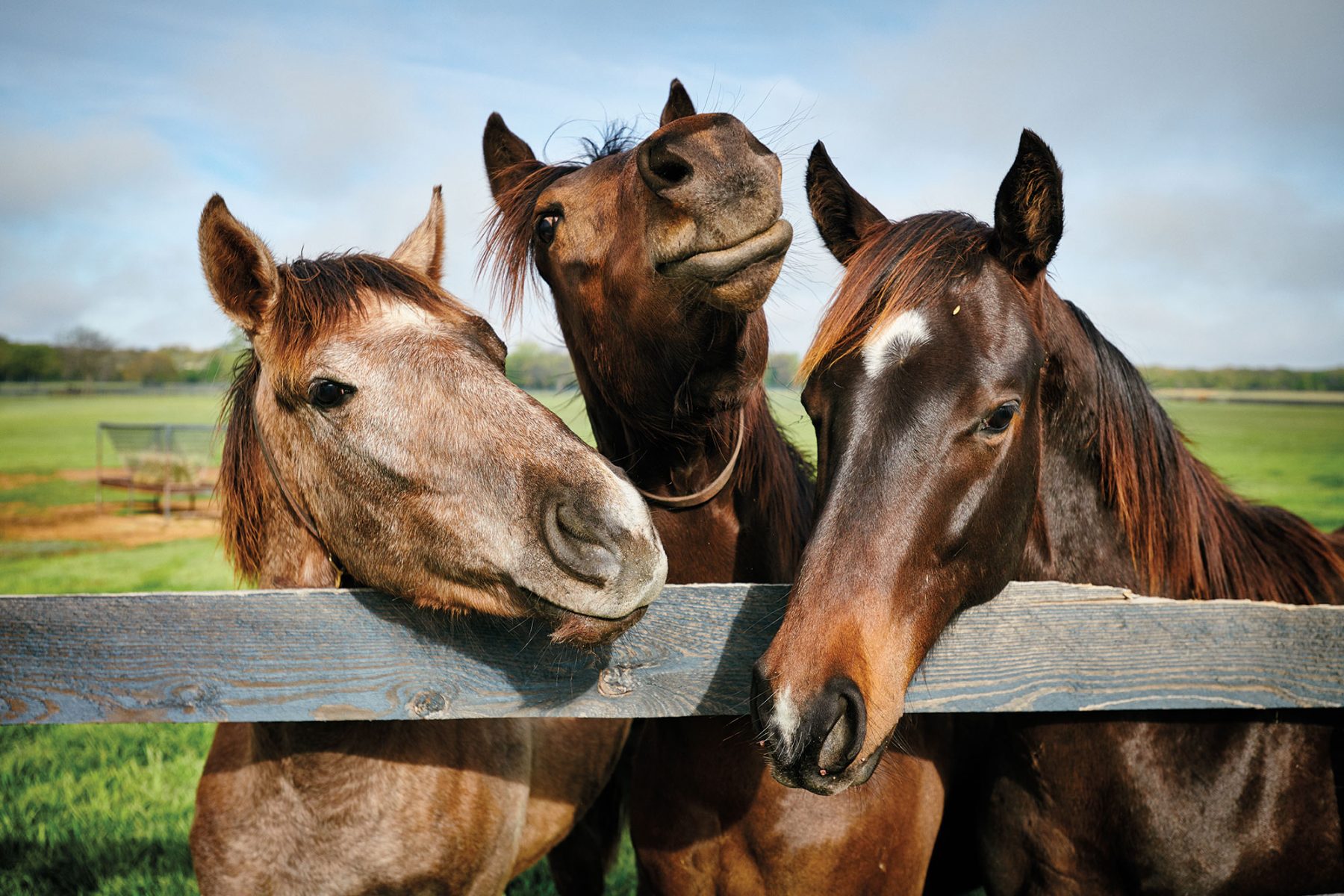Editor’s note: This story was published in the September 2019 issue. Horse Country Tours closed due to the COVID-19 pandemic and has not reopened—please check Discover Denton prior to planning a trip.
Here’s something you don’t get to see every day: a huge stallion working out on a treadmill in a hydrotherapy tank recessed below the floor of a barn. This isn’t any old horse, nor is this any old barn. This is a state-of-the-art facility at Tom McCutcheon Reining Horses, an 80-acre ranch just north of Denton in Aubrey. The center breeds, raises, trains, treats, and sells some of the most elite equine athletes in the world.
You don’t have to be the moneyed owner of an expensive Western-performance or hunter-jumper horse to see such magnificent animals in this exclusive setting. Some of the premier horse farms and ranches of North Texas grant inside access to their facilities and their resident four-legged celebrities. Six behind-the-scenes public bus tours are offered each year—three in the spring and three in the fall—as well as private group tours by appointment. Winding through countryside once devoted to peanut farms, each six-hour bus tour stops for visits at two of the more than 350 horse farms that collectively stable roughly 40,000 animals.
“A lot of people, even people living nearby in the Dallas area, might not realize that North Texas is a true equine mecca,” says Dana Lodge of the Denton Convention & Visitors Bureau, which organizes the tours.
From American quarter horses, thoroughbreds, and American paint horses to Appaloosas, Arabians, and pasos; from reining and cutting to barrel racing and track racing, North Texas horse country is home to a remarkable variety of breeds and disciplines. This is the horse epicenter of the Lone Star State, which is saying something when you consider that Texas is home to more horses than any other state in the union.
Good Dirt
Why does so much horsepower converge on North Texas? “It’s all about the sandy loam. The soil is good for their hooves,” Lodge explains. “Between the soil and the climate, this region is ideal for working horses.” As the tour guides explain, sandy loam consists of less than 7 percent clay, less than 50 percent silt, and between 43 and 50 percent sand. There’s a great swath of it in North Texas covering an area about 45 miles wide and 90 miles long from the Red River to south of Fort Worth. On the western fringes of the sandy loam, Weatherford. On the eastern edge, Sherman.
The well-drained, gently sloping land and mild winters that allow for almost year-round training started attracting horse farms and professional horsemen in the 1970s. As the industry grew, so did the economic impact and the area’s reputation for equine excellence.
Horse aficionados, including some famous names, are well-aware. At McCutcheon’s ranch, for example, musician Lyle Lovett keeps his quarter horse Smart and Shiney in breeding residence. In the farm’s trophy-filled viewing area, visitors can see Smart and Shiney’s stallion card—a glossy 8½-by-11-inch glamour shot with stats on the back that document his lineage and accomplishments. The card is like a cross between a model’s one-sheet, a professional resume, and a sperm donor’s profile. “The more black type on the card,” the tour guide says, “the more prestige and money won.”
Click the image above to view the slideshow.
Why does so much horsepower converge on North Texas? “It’s all about the sandy loam. The soil is good for their hooves.”
McCutcheon’s trophy room also provides a window view of the arena, where visitors look on as trainers like Cade McCutcheon work with both green horses learning the ropes and celebrity horses getting serious workouts. It’s a marvel to watch as Cade puts a reining horse through its paces, maneuvering the quarter horse like a driver maneuvers a car: drive forward, back up, circle, turn on a dime, slide to a dramatic dust-raising stop.
Behind the Scenes
The tours vary depending on which ranches they visit and what’s happening on any given day. But all provide an authentic first-hand look at horse people going about their business—a farrier shoeing; a horse getting a thorough scrub; over here, a rubdown; over there, a towel-
off. From January through June, you’re likely to see foals. You might even meet owners, if they’re around, or get a chance to talk with breeding managers.
The facilities treat their horses like the sports professionals they are. McCutcheon’s rehabilitation manager, Shannon Kernan, works with horses in a heated underwater treadmill, which is used for exercise, fitness, and post-operative care. “It’s like water aerobics and physical therapy,” Shannon says. “It’s good for their minds, too.” Or you might see a horse having a hydrotherapy treatment. “It’s like a cold saltwater spa,” she explains. “It dries out inflammation in legs or abscesses and fungus.”
Click the image above to view the slideshow.
Click the image above to view the slideshow.
For safety reasons and somewhat graphic content, the tours are not appropriate for young kids. McCutcheon’s isn’t shy about revealing some of the finer anatomically correct points of the breeding side of the business. The tours sometimes go into detail about how semen is collected from stallions for impregnating mares, either at the farm or for shipment.
The facilities treat their horses like the sports professionals they are, using tools like underwater treadmills and hydrotherapy.
“One collection can impregnate up to several mares,” Breeding Manager Kelse Clark-Fernandez points out. Semen can be shipped anywhere. That’s why you see FedEx trucks driving around horse country, the tour guides explain with unembarrassed candor: They’re ferrying stallion semen to DFW Airport for delivery all over the world.
Horses on a Hill
In the rolling countryside of Pilot Point, you’ll find Valor Farm. From the looks of the place, it could be a resort. Set on land that might be mistaken for a Kentucky thoroughbred farm, this is strictly a breeding ranch. Every bus tour incorporates Valor Farm, at least for a drive-through, if not a full behind-the-scenes visit.
It’s easy to see why this place is a crown jewel. The wrought-iron gates open to a tree-lined drive, and immaculate wood fencing extends in orderly fashion across some 400 rolling acres punctuated by oak trees. Clarence and Dorothy Scharbauer bought the land in 1991. Within two years, the former president of the American Quarter Horse Association and his wife, who owned racehorses from a young age, had built the barns and 18 miles of fencing. Today, both have passed on, and Valor Farm is owned by their son Douglas Scharbauer.
The offices sit in red-brick majesty at the top of a hill, presiding over a stallion barn, a breeding barn, and a mare barn. Valor Farm has hosted some of the Southwest’s top stallions, including the great thoroughbred racehorse Alysheba, who won two legs of the Triple Crown in 1987 and sired 11 horses that have gone on to win high-profile races.
Click the image above to view the slideshow.
Click the image above to view the slideshow.
Visitors can watch as stallions are led into the barn, looking the part in the rarefied surroundings and appearing unconcerned about their duty. If you go behind the scenes at Valor Farm, employees will explain that teaser stallions of lesser quality often “tease” the mare so breeders are 100 percent sure the mare will accept the male. Once that’s established, they bring in the expensive stallion.
Driving through Valor Farm is a show in itself—the manicured grounds and pond, the miles of fencing, and the “foaling barn/mare motel,” where the mares closest to delivering are kept. In big paddocks, the horses have plenty of room to run and build leg muscles. The standoffish stallions look back at oglers like they somehow understand they’re the main attraction.
And with good reason. Even if you opt for one of the self-guided tours and drive through North Texas horse country on your own, you’re in for a treat. Ranch after ranch, fence line after fence line, paddock after paddock, you’ll see man’s other best friend: horses, in all their glory, dotting the landscape as far as the eye can see.





















